 CONSTRUCTION
OF A FIGHTER COCKPIT
CONSTRUCTION
OF A FIGHTER COCKPIT
This article is tailored for those who are building a jet fighter cockpit,
although some of the basic principles will also apply to other types of
simulators. But overall, this article is intended for those who feel the
need, the need - for speed (and Gs)! Also, this article is simply my opinion
and some might disagree with my approach to building a fighter cockpit
and how it feels to fly in a real fighter. If nothing else I hope I get
people to try and visualize what it is really like to fly a modern jet
fighter as we attempt to replicate as close as possible the combat flight
experience. In the civilian world it is often said that flying amounts
to long periods of time filled with boredom punctuated by moments of sheer
terror. In combat it can sometimes be the other way around.
PHASE ONE
PREPARATION
To some the first step to building a Simulator Cockpit may seem like
stating the obvious, but will prove critical at later stages of your project.
You must first decide what kind of cockpit you are going to build. If it
is to be a close replica of an aircraft then you will need to find basic
measurements of the cockpit to be copied, such as the size of the instrument
panel. 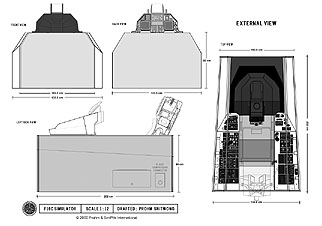 If
you ever use real aircraft parts, this becomes critical to making sure
the real parts will fit where they belong. Get as much information
as possible about the type of aircraft you want to simulate so that you
can make a detailed replica. This also applies to the operation of the
switches when the simulator is operational. Paying attention to the little
details really adds to the "feel" of your cockpit. For my project I have
started a mini database
of books and videos for the type of aircraft I am replicating. If you can
find a museum that has the type of cockpit you are trying to build then
get out your measuring tape, paper, and pen and get busy.
If
you ever use real aircraft parts, this becomes critical to making sure
the real parts will fit where they belong. Get as much information
as possible about the type of aircraft you want to simulate so that you
can make a detailed replica. This also applies to the operation of the
switches when the simulator is operational. Paying attention to the little
details really adds to the "feel" of your cockpit. For my project I have
started a mini database
of books and videos for the type of aircraft I am replicating. If you can
find a museum that has the type of cockpit you are trying to build then
get out your measuring tape, paper, and pen and get busy.
Even if you are going to build a generic simpit you should still get
some measurements for your cockpit in at least two areas, the side panels
and the area where the ejection seat will fit.
In my cockpit I decided I wanted to put some real instrument boxes in
the side panels and then to my distress I realized that the panels and
instrument boxes I had previously fabricated were an inch wider than the
real ones.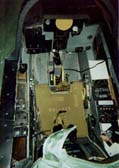 Taking the time to find out the normal size of a typical panel box at the
beginning of my project would have avoided this problem. The typical width
of an instrument box is 5 1/4 inches.
Taking the time to find out the normal size of a typical panel box at the
beginning of my project would have avoided this problem. The typical width
of an instrument box is 5 1/4 inches.
I waited to build my replica ejection seat until after the main construction
of the cockpit was finished, so why bother with a specific width of the
cockpit when I started the main cockpit construction? I ended up buying
a real Martin Baker seat when the opportunity 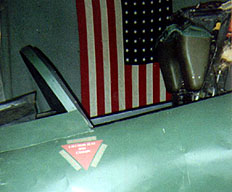 unexpectedly
presented itself. Fortunately, I had built the inside of the cockpit wide
enough for the seat to fit. Do you think you would buy a seat for your
cockpit, if you could? Who knows what might happen in the future. Be prepared!
If nothing else, these measurements will help to make your simulator look
more like a real aircraft cockpit. Just think of it as another one of those
little details. The width of a Martin Baker MK-7 seat is approximately
21 inches.
unexpectedly
presented itself. Fortunately, I had built the inside of the cockpit wide
enough for the seat to fit. Do you think you would buy a seat for your
cockpit, if you could? Who knows what might happen in the future. Be prepared!
If nothing else, these measurements will help to make your simulator look
more like a real aircraft cockpit. Just think of it as another one of those
little details. The width of a Martin Baker MK-7 seat is approximately
21 inches.
Next it is good to try and visualize what it is that you are trying
to accomplish with your cockpit. But first I think I must make my first
confession, in my quest to build a jet fighter simulator I strive for maximum
realism. I'm not a gamer. I simply love aviation. In real life I try to
fly as much as possible so coming home to simply play an airplane game
on a computer is boring compared to the sensations of real flight. But
even worse is if a full sized simulator cockpit INCORRECTLY replicates
the flying experience. This really annoys me, especially if it has a motion
system providing inaccurate input. But more about that later. I also like
things to be extreme, especially when it comes to flying, so what could
be better than a highly maneuverable jet fighter?
Ok, so now to continue with my second point, what is it that you are
trying to accomplish? What are our goals? With my F-4 cockpit I am trying
to make the artificial flying experience as IMMERSIVE and REALISTIC as
possible. If the immersion is enough then your body will be fooled into
telling your brain that you are indeed flying through the air at mach 1
with your hair on fire (hmm, on second thought, I don't know how good that
really sounds). When people take the controls of your cockpit will they
leave with a feeling of "wow, that was a great game!" or will it be "wow,
that airplane almost made me airsick!" Since my goal is to forget that
I am even on the ground I think we should take a close look at what flying
a real jet is like, or at least what I think it is like. This brings me
to my second confession. Most of my flying time has been in Cessna 172s.
That's a good plane, but it's flying characteristics are far different
than a jet fighter. My limited amount of acrobatic time was in the back
seat of a WW-II era T-6 Texan pulling three G loops and rolls. However,
the descriptions I am about to write can be verified by actual jet fighter
pilots.
TO FLY A REAL FIGHTER
When modern jet fighters start maneuvering the flying experience turns
into an extreme physical test. Pilots don't fly around yelling "yahoo!"
and talking cool to their buddies while they're pulling g's as is often
seen in movies such as Iron Eagle. 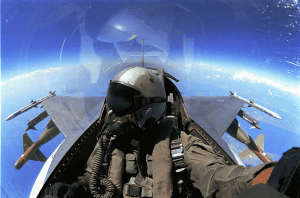 They
are grunting and squeezing their stomach muscles in an effort to simply
stay conscience. Flying maneuvers in a modern fighter generates a physically
demanding environment that few who have never done it understand. After
pulling G's for a few hours on a combat mission pilots will often land
at base very sweaty and extremely tired. I heard that F-16 pilots sometimes
have red foreheads because of blood vessels breaking under the skin.
They
are grunting and squeezing their stomach muscles in an effort to simply
stay conscience. Flying maneuvers in a modern fighter generates a physically
demanding environment that few who have never done it understand. After
pulling G's for a few hours on a combat mission pilots will often land
at base very sweaty and extremely tired. I heard that F-16 pilots sometimes
have red foreheads because of blood vessels breaking under the skin.
While not anywhere close to being physically debilitating, I could feel
the effect of the 3+ g's in my T-6 ride. The most noticeable effect was
how the forces made my head feel heavy, and it took a lot more effort than
normal to hold my head upright to look out of the cockpit. My whole body
felt the g forces forcing me into the seat. I know if the maneuvers had
been prolonged it would have worn me out.
A fighter jet will regularly pull four to six g turns during a sortie
and some fighters like the F-15 Eagle will occasionally pull up to 9. This
kind of g's makes it hard to breathe and your whole body feels like it
is being smashed. The pilot has to brace both mentally and physically before
going into these kinds of maneuvers to keep from passing out.
When a fighter accelerates in a turn, spin, or loop, the pilot must
be careful not to jerk his head up, down, or sideways, or the pilot can
end up getting the sensation of tumbling in space and can also get motion
sickness. This is called the Coriolis illusion and it can cause a pilot
to lose his combat edge or even crash his plane.
While flying the plane through these physically demanding maneuvers
the pilot must keep situational awareness by monitoring his instruments
and keeping a visual watch outside the cockpit. With speeds in combat ranging
from 300 to 800 knots, the pilot most think ahead of the aircraft in order
to end up where he wants to be. Otherwise, the pilot will find himself
plowing a hole in the ground, or in the sights of a hostile aircraft, and
all the while the g forces and whiplash create a situation where it is
even easier for the pilot to become disoriented and confused.
ERWIN’S T-37 FLIGHT
Here is a story by Erwin
Neyt telling about one of his flights in a T-37, explaining how
easy it is to get into trouble.
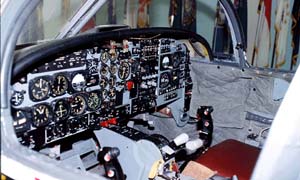 "I
was out on a solo flight, flying a contact mission. The main goal is to
master energy control. As you know, energy is very important to a fighter
pilot. If he finds himself low on energy during an enemy encounter, he
as good as dead. Doing basic flight maneuvers, I found myself on the top
of my designated airspace block. High on altitude I assumed I was low on
speed. Quickly checking my airspeed I saw 20 on the drum. 120 knots, perfect
for a split-S to set me up for the Cuban-8 I had planned. I rolled over
and pulled into the split-S. As I pulled, I immediately figured there was
something wrong. I was already 30 degrees nose down when I realized the
aircraft (a T-37) was reacting too well to the controls: the airspeed was
wrong. I immediately performed a recovery, checking my speed again: 250
knots! I must have entered with 220 instead of 120. 220 also has 20 on
the drum: I missed the needle! After I rolled out of the belly up dive
I found myself in a high speed dive, pulling max allowed g's. With 7 g's
on the clock and trying to push as much blood to my brains (the T-37 has
no g-suit support), my vision rapidly faded. Just before I grayed out (tunnel
vision) I trimmed the aircraft, hoping to get the aircraft up, even if
I lost control. I knew G-LOC was waiting to get my butt, but my butt is
what did save me. In the last part of the recover, after I lost sight,
all I could feel were the g-forces pulling my butt in the seat. I knew
I had to stop pulling before it was to late, but I didn't know where the
ground was. Having trimmed the aircraft, I felt the force diminish after
the plane came to a nose up position and started to climb. My butt told
me! I pushed on the stick and regained my vision. After I trimmed the plane
back to normal and checked if I had not over-stressed the aircraft, I saw
I lost twelve thousand feet during the recovery. They didn't assign the
high areas to rookie pilots for no reason! Looking back on this moment,
I realize that these kind of thrilling experiences would be very hard to
replicate in a simulator. "
"I
was out on a solo flight, flying a contact mission. The main goal is to
master energy control. As you know, energy is very important to a fighter
pilot. If he finds himself low on energy during an enemy encounter, he
as good as dead. Doing basic flight maneuvers, I found myself on the top
of my designated airspace block. High on altitude I assumed I was low on
speed. Quickly checking my airspeed I saw 20 on the drum. 120 knots, perfect
for a split-S to set me up for the Cuban-8 I had planned. I rolled over
and pulled into the split-S. As I pulled, I immediately figured there was
something wrong. I was already 30 degrees nose down when I realized the
aircraft (a T-37) was reacting too well to the controls: the airspeed was
wrong. I immediately performed a recovery, checking my speed again: 250
knots! I must have entered with 220 instead of 120. 220 also has 20 on
the drum: I missed the needle! After I rolled out of the belly up dive
I found myself in a high speed dive, pulling max allowed g's. With 7 g's
on the clock and trying to push as much blood to my brains (the T-37 has
no g-suit support), my vision rapidly faded. Just before I grayed out (tunnel
vision) I trimmed the aircraft, hoping to get the aircraft up, even if
I lost control. I knew G-LOC was waiting to get my butt, but my butt is
what did save me. In the last part of the recover, after I lost sight,
all I could feel were the g-forces pulling my butt in the seat. I knew
I had to stop pulling before it was to late, but I didn't know where the
ground was. Having trimmed the aircraft, I felt the force diminish after
the plane came to a nose up position and started to climb. My butt told
me! I pushed on the stick and regained my vision. After I trimmed the plane
back to normal and checked if I had not over-stressed the aircraft, I saw
I lost twelve thousand feet during the recovery. They didn't assign the
high areas to rookie pilots for no reason! Looking back on this moment,
I realize that these kind of thrilling experiences would be very hard to
replicate in a simulator. "
Erwin's experience shows us how easy it is to make a small mistake and
how the g forces induced by turning at high speeds compound the mistake
by degrading the pilot's situational awareness and his ability to maintain
control of the aircraft. He also illustrates how physically demanding flying
can be.
The idea behind a simulator cockpit is to simulate the flying experience
as close as possible. To do this I suggest you think about a real fighter's
axis of motion, roll, yaw, and pitch, as you build your cockpit. What effect
would it have to yank your stick to the left in a modern fighter? Do you
think you would feel a little whiplash? Do you think you would be strapped
in tight to help negate the whiplash, or would there be a little slack
in the harness so that you could turn and check your 6 o'clock position
a little more easily? Have you ever thought about why jet pilots have to
wear a huge helmet? Just think of the effect of having your head slammed
against the canopy if you didn't have a helmet on. While there are limits
to our abilities to simulate a fighter, particularly in regards to g and
the extreme physical experience as per the previous descriptions of real
flight, we can make CUES that will cause us to be PHYSICALLY AWARE that
we are doing an extreme maneuver. To accomplish this will bring the simpit
builder a very rewarding simulation experience.